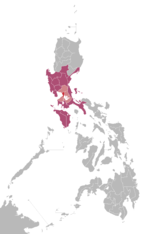DZBB-TV
 | |
| Metro Manila Philippines | |
|---|---|
| City | Quezon City |
| Branding | GMA TV-7 Manila |
| Slogan | Buong Puso Para sa Kapuso |
| Channels |
Analog: 7 (VHF) Digital: 27 (UHF) (ISDB-T) (test broadcast) Virtual: 07 (LCN) |
| Subchannels |
07.01: GMA 07.02: GMA News TV (DZOE-TV) 07.04: GMA (1seg) |
| Translators |
D-5-ZG 5 Iba, Zambales D-5-ZB 5 Baler, Aurora D13ZR 13 Occ. Mindoro |
| Affiliations | GMA Network (O&O) |
| Owner | GMA Network Inc. |
| Founded | October 29, 1961 |
| Call letters' meaning |
DZ Bisig Bayan (named after sister radio station DZBB) or "Uncle BoB" Stewart (founder) |
| Sister station(s) |
DZOE-TV (GMA News TV) DZBB-AM DWLS |
| Former callsigns | None |
| Transmitter power | 100,000 Watts TPO |
| Transmitter coordinates | 14°40′12″N 121°3′0″E / 14.67000°N 121.05000°E |
| Website | GMA Network.com |
DZBB-TV, channel 7, is the flagship VHF television station of GMA Network in the Philippines. Its studios are located at the GMA Network Center, at the corner of Timog Avenue and Epifanio de los Santos Avenue in Quezon City, while its transmitter station is located at the GMA Tower of Power, Tandang Sora Avenue, Barangay Culiat, Quezon City.
History
DZBB-TV traces its history to Metro Manila radio station DZBB, owned by Loreto F. de Hemedes, Inc.,[1] later renamed Republic Broadcasting System, Inc. of Robert "Uncle Bob" Stewart. After the success of its radio station, the company ventured into television. On October 29, 1961, RBS Channel 7, the third television station in the Philippines (after ABS Channel 3 and CBN Channel 9, which were owned by ABS-CBN which now owns Channel 2 in Manila), started operations with just 25 employees (other stations had 200), a surplus transmitter, two old cameras and no lighting equipment and props.
The station was always in the red and Stewart was about to give up; when the program "Dancetime with Chito" suddenly became an instant hit and advertising revenues started to pour in. Canned programs from the United States further sustained its success.

In 1972, President Ferdinand Marcos declared martial law in the Philippines and the station was forced to shut down, though it only lasted for more than 3 months, and returned on the air in late-December of that year; this time, blocktimed by the National Media Production Center (NMPC) with limited three-month permits.[2] In 1974, RBS, including its TV and radio stations, were sold to a triumvirate composed of Felipe Gozon, Gilberto Duavit, Sr., and Menardo Jimenez who introduced a programming concept catering to the new audience. The new management acquired new equipment and introduced new programs and a new name, GMA (Greater Manila Area) Radio-Television Arts with its new identity, "Where You Belong" in 1979.

Light red and red: Market audience of GMA 7 Manila
Violet: Areas that may receive signals from GMA 7 Manila
When democracy in the Philippines was restored in the People Power Revolution in 1986, other television stations began to air, some with their original owners. The political instability of the country also added to the station's burden, when soldiers stormed into its studios for two days in a part of coup attempt to topple then President Corazon Aquino.
On July 1987, GMA introduced its new dimension in television broadcasting as the network was transmitted in full stereo, dubbed as GMA StereoVision, and became the first Philippine TV station to broadcast programs in full stereo until 1998 when it switched to the current 100 kilowatt capacity.
On November 7, 1988, DZBB officially inaugurated a new 100,000 watt transmitter in Quezon City. Known as the "Tower of Power", the 777 ft (236.8 m) transmitter helped improve the channel's reception in Luzon, and was also the tallest man-made structure in the country at the time.[3]
Digital television
Digital channels
According to a December 2017 press release, the upgraded GMA's digital television signal transmission covered the areas of Metro Manila, Rizal, Cavite, Laguna, Bulacan and parts of Pampanga, Bataan and Nueva Ecija.
| Channel | Video | Aspect | PSIP Short Name | Programming | Note |
|---|---|---|---|---|---|
| 07.01 | 480i | 4:3 | GMA | GMA | Commercial broadcast |
| 07.02 | GNTV | GMA News TV | |||
| 07.04 | 240p | 4:3 | GMA1SEG | GMA 1seg | 1seg broadcast |
References
- ↑ GMA Network Corporate Information Archived August 16, 2008, at the Wayback Machine., GMANetwork.com
- ↑ GMA Network's (History/Timeline/Milestones)
- ↑ Pres. Aquino switched GMA-7's 'Power Tower, Manila Standard, November 7, 1988
- "GMA Turns Gold". Manila Bulletin. June 14, 2000. pp. S1–S12.
- Anastacio & Badiola. "what's the story, pinoy tv?". Archived from the original on 2005-09-08. Retrieved August 21, 2006.